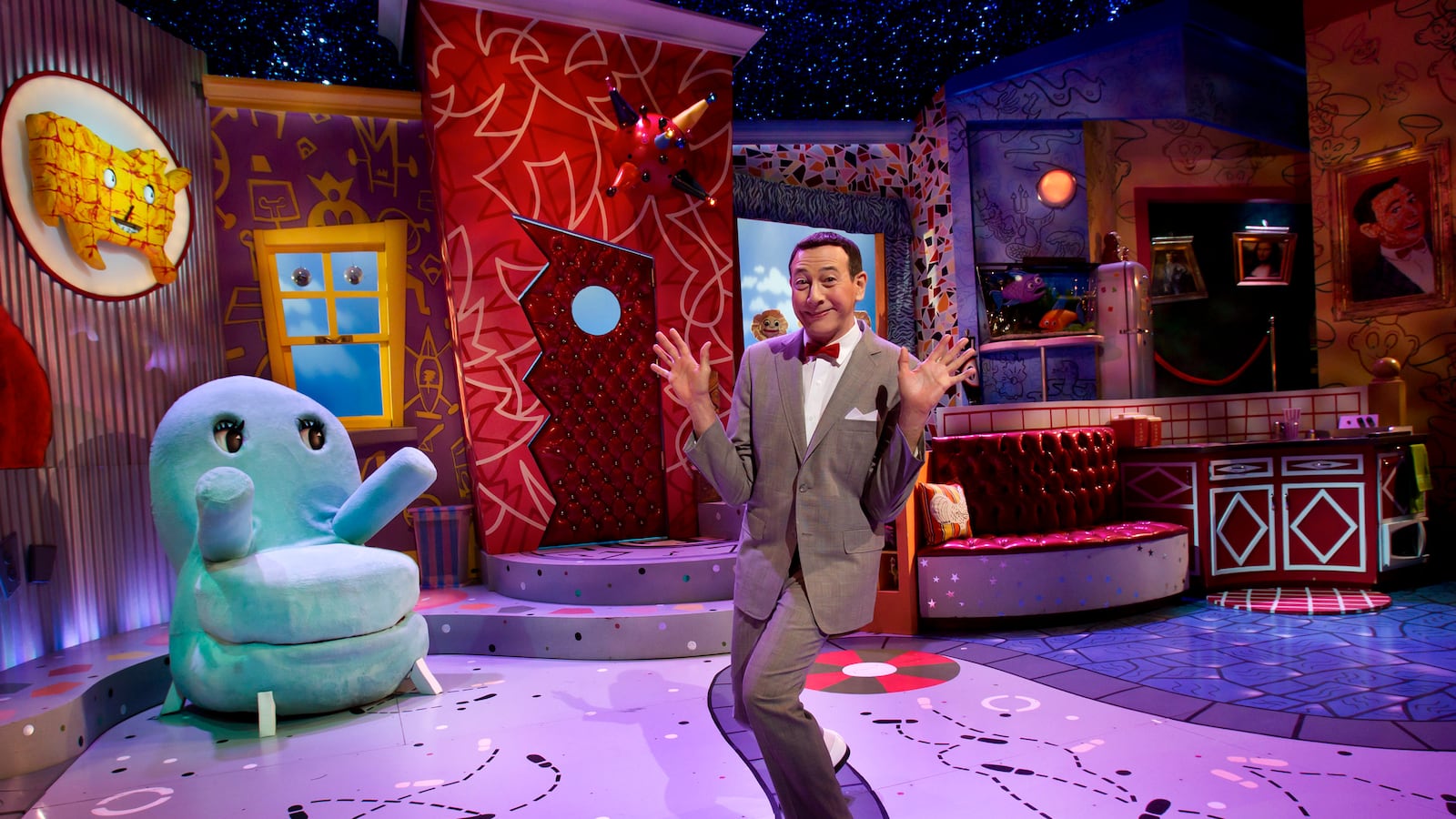Earlier this year, the Wall Street Journal published an article about MKG, a Manhattan-based “experiential marketing, social media and branding agency” that’s become known for its lavish, company-wide summer parties. At the suggestion of founder Maneesh Goyal, the company went with a Pee-wee Herman theme. At 39, Goyal grew up with Pee-wee’s Playhouse, the Saturday-morning kids’ show starring Paul Reubens, creator of the Pee-wee Herman character. Many of his guests were younger than Goyal, however, and did not grow up with Pee-wee’s Playhouse. But, Goyal noted, “they have heard of it,” adding, “We were doing a bit of education.”
With a few long-lived exceptions like Sesame Street and SpongeBob SquarePants, kids’ shows tend to be generational, with strata existing even within generations. A child born in 1967 probably grew up watching H.R. Pufnstuf while one born just a few years later would never have heard of the show. But surely Pee-wee’s Playhouse, the most creative and endearing kids’ show of its era, deserves a better fate.
In 1986, Pee-wee’s Playhouse landed like a candy-colored bombshell in the middle of CBS’ Saturday-morning line-up, shaking up a landscape of children’s programming usually defined by merchandise line extensions, like The Smurfs and Adventures Of The Gummi Bears. A refinement of Reubens’s popular early-’80s stage show, The Pee-wee Herman Show, Pee-wee’s Playhouse was at once traditional and innovative. An overgrown child in a too-small suit, Pee-wee took the place of past kids’ show hosts like Captain Kangaroo and Uncle Al. The show surrounded him with puppets, animation of all sorts, and colorful characters like the flirtatious, bouffant-bedecked Miss Yvonne (Lynne Stewart) and the Jheri-curled Cowboy Curtis (Laurence Fishburne). The show ran for five seasons, earning both popularity and acclaim in the process.
The rare instance of a work improving by being softened for a wider audience, Pee-wee’s Playhouse had a strange evolution from stage to television. What began, staged under the name The Pee-wee Herman Show, as a chance for midnight audiences to watch members of L.A.’s famed Groundlings troupe parody the children’s programming of their youth with, their strong values and lessons in good behavior became a sterling modern example of the same for the next generation. Reubens went from making fun of kids’ TV to legitimately making it, using wild imagery and a manic pace to impart timeless lessons. It was the hippest square show on television, even as it has since largely receded from view.
The new Pee-wee’s Playhouse: The Complete Series, an eight-disc Blu-ray set from Shout! Factory, a label specializing in thoughtful reissues, collects all 45 original episodes of the series as well as a primetime Christmas special that aired in 1988. Beautifully restored from the series’ original elements—Reubens insisted on shooting on film despite the cost advantages of videotape—the show looks like it could have been made yesterday. That’s fitting, because part of what made Pee-wee’s Playhouse work was that it always seemed like a show out of time, drawing freely from past eras to create a world onto itself.
Consider Conky 2000, Pee-wee’s faithful robot and the source of each episodes word of the day. Made up of a boombox, a typewriter, what appears to be an ancient toaster oven, a turntable, and other bits of salvage, he is primarily the creation of puppeteer Greg Harrison, according to Caseen Gaines’s 2011 behind-the-scenes history Inside Pee-wee’s Playhouse. In Harrison’s hands, Conky became more than the sum of his scrap parts: What might have been a pile of yesterday’s junk became a living, if not exactly breathing, resident of the playhouse as alive as any of the humans near him.
Harrison was part of a production design team headed by underground artist Gary Panter, who also worked on Pee-wee’s stage incarnation. As Panter explains on the Blu-ray set’s making-of features, they treated it as a chance to create a “psychedelic hippie show,” using a thrift-store aesthetic. The set of Pee-wee’s Playhouse, constructed in a New York loft for the show’s first season then expanded to a larger studio set when the series moved to Los Angeles for subsequent seasons, polished up and gathered together the cultural detritus of yesteryear: old diner booths, cowboy bedsheets, a beatnik animal band, flowers that sing like the Andrews Sisters, children dressed as hippies.
It’s the happy flip side of Dean Stockwell’s garish hangout in David Lynch’s Blue Velvet. Instead of re-creating the heart of the 20th century as a nightmare, it turned the best parts of those decades into a funky paradise.
It was just as much a contemporary vision, however. Turning his back on the lily-white images of the TV of his own childhood, Reubens insisted on a multicultural cast before that became the norm (if it’s even the norm now). In addition to Cowboy Curtis, regular visitors to the playhouse included The King of Cartoons (played first by Gilbert Lewis then by Blacula star William Marshall), Reba the Mail Lady (S. Epatha Merkerson) and Latino regulars Tito (Roland Rodriguez) and Ricardo (Vic Trevino).
The show also created a real sense of drama on a child-sized scale. In the second-season episode “Puppy in the Playhouse,” Pee-wee finds and falls for a stray puppy, then has to decide whether to let Reba know of his discovery when she arrives at the playhouse distraught at having lost her new dog. The episode doesn’t draw the dilemma out all that long and Pee-wee, of course, does the right thing. But Reubens and a tearful Merkerson share a moving moment that conveys to kids that behaving selfishly can, and usually does, come at a cost for others.
Each half-hour followed the same formula: the unveiling of the day’s secret word, a visit from The King of Cartoons, a “Penny” cartoon that transformed the ramblings of a little girl into a stop-motion adventure, a trip inside Magic Screen, a wish from Jambi, some time with Miss Yvonne, Pee-wee’s departure by scooter, and so on. Kids saw Pee-wee as one of their own, an excitable, fun-loving creature of impulse who delighted in wordplay and broad jokes, and lived for playtime. But he also doubled as a tour guide through episodes Reubens and the writing staff filled with lessons about safety, courtesy, hygiene, and other topics. It offered education and moral guidance inside the Trojan horse of entertainment.
So why does its fandom seem largely limited to the Gen Xers who saw the show in its first run? It’s not that Pee-wee Herman has fallen into obscurity, though the character and Reubens’s time in the pop-cultural wilderness probably hasn’t helped. Reubens’s high-profile arrest in 1991 for indecent exposure at an adult theater led to a lower profile for Reubens and the near-disappearance of Pee-wee for years.
Though the incident, which almost certainly wouldn’t dominate headlines now the way it did then, prompted more sympathy than outrage, CBS pulled the last few reruns of the show from the air (ending its network run) and toy stores boxed up the Pee-wee toys still on the shelf. Pee-wee’s Big Adventure, the character’s 1985 big-screen debut directed by Tim Burton, remains a popular cult film. Pee-wee’s Playhouse has been reissued both on VHS and DVD, but it’s never enjoyed the long afterlife in reruns needed to keep kids’ shows in the public consciousness. Its most prominent airings came in 2006, as part of the Cartoon Network’s late-night Adult Swim.
Which raises another question: Who is Pee-wee Herman for in 2014?
When Reubens revived the Pee-wee for stage appearances in 2010, he had no trouble filling theaters in Los Angeles and New York in a re-tailored version of the stage production that first made Pee-wee an underground sensation. Audiences saw a more risqué, self-consciously ironic version of the Saturday morning favorite and a more peevish version of Pee-wee. Little in the revived Pee-wee Herman Show made it unsuitable for children—except maybe a long, unfunny riff about Pee-wee’s abstinence ring—but children were clearly not the primary audience. Like the original version in 1981, the 2010 revival aired as a special on HBO. In the shots of the audience, there’s not a kid in sight.
Reubens has long talked about reviving Pee-wee for another movie, the character’s third after 1988’s disappointing Big Top Pee-wee. He’s teased a darker perils-of-fame story called The Pee-wee Herman Story and a more kid-friendly Pee-wee’s Playhouse film. Starting last year, he began discussing a third option to be produced by Judd Apatow as well as a revived version of Playhouse, both set to appear in 2014. So far, nothing has materialized (though Reubens did star in a clever recent TV On The Radio video).
Reubens developed a reputation as a perfectionist in the 1980s, which might be slowing things down, though Reubens recently told Rolling Stone an announcement is “very imminent.” But an identity crisis could also be getting in the way. In 2014, is Pee-wee Herman a children’s entertainer or a throwback for adults who want to see a figure from their childhood knocking back shots and assaulting Anderson Cooper? Of late, we’ve only gotten the grown-up Pee-wee, the one that circled all the way back to the ironic distance of the character’s early days. He’s clever. But the other Pee-wee, the one that knew how to talk to kids without talking down to them and entertain grown-ups at the same time? A return trip to Pee-wee’s Playhouse confirms he’s a genius.






